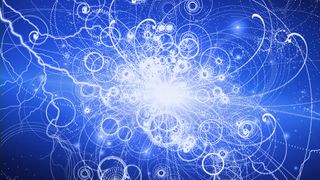Imagine for a moment a universe devoid of the fundamental building blocks of matter. What would an existence without protons, neutrons, and electrons look like? In pondering this playful question, we stumble upon the enigmatic world of quarks—a cornerstone of particle physics that embodies the essence of matter itself.
At the heart of the matter, quarks appear as elementary particles that, when combined, form protons and neutrons, the constituents of atomic nuclei. These infinitesimal entities are a pivotal element of the Standard Model of particle physics, which attempts to describe the behavior of matter and the fundamental forces of nature. Quarks are distinguished not only by their properties and behaviors but also by their extraordinary roles in the grand tapestry of the universe.
Quarks exhibit six types, or “flavors,” namely up, down, charm, strange, top, and bottom. Each flavor is characterized by its own unique mass and charge. For instance, the up quark possesses a charge of +2/3, while the down quark carries a charge of -1/3. This intriguing arrangement results in the emergence of baryons—such as protons and neutrons—composite particles that can be conceived as trios of quarks. A proton, for instance, is composed of two up quarks and one down quark, while a neutron consists of two down quarks and one up quark. Can you appreciate the symphonic resonance of these subatomic arrangements, echoing through the fabric of existence?
The interplay of quarks extends beyond mere combinations. It is essential to note that they are bound together by the strong nuclear force, mediated by particles called gluons. The dynamic interaction between quarks and gluons manifests through the phenomenon of color charge, akin to the way light and color influence our visual perceptions. In this context, “color” does not refer to visible hues but rather a property unique to quarks. Each quark is assigned one of three “colors” (red, green, or blue), with their combinations ultimately leading to “neutral” or colorless states—essential for the formation of stable particles.
In examining the peculiarities of quarks, it is vital to contextualize their existence in terms of confinement and asymptotic freedom. Confinement is a principle that asserts that quarks cannot exist in isolation; they are invariably tethered within larger particles. This phenomenon is graphically illustrated when observing high-energy collisions in particle accelerators like the Large Hadron Collider, which allow researchers to probe the behaviors of quarks under extreme conditions. Conversely, asymptotic freedom describes the propensity for quarks to interact less strongly at smaller separations—a revelation that epitomizes the dual nature of strong interactions.
The associated complexities of quark dynamics challenge our understanding of fundamental symmetries and conservation laws in particle physics. For instance, the processes of flavor-changing transitions, where one type of quark metamorphoses into another, expose intriguing aspects of the weak nuclear force. This force is responsible for processes such as beta decay, where a neutron transforms into a proton, emitting an electron and an antineutrino in the process, effectively shifting the quark content of the corresponding nucleon.
Delving deeper into the realm of quarks, one encounters the concept of quark-gluon plasma—a state of matter theorized to exist at extremely high temperatures and densities, akin to conditions present just after the Big Bang. At this juncture, quarks and gluons cease to be confined and exist freely in a hot, dense “soup” of fundamental particles. The experimental recreation of this exotic state in high-energy collisions offers tantalizing glimpses into the early universe’s characteristics and evolution.
Furthermore, the observation of exotic baryons and mesons, which incorporate heavier quarks, such as charm and bottom quarks, challenges traditional notions of particle classification. These exotic states enrich our understanding of the strong force’s intricacies and ignite ongoing research into their formation, decay, and underlying principles.
The distinct flavors of quarks intertwine with the realm of mass, particularly elucidated through the Higgs mechanism. The discovery of the Higgs boson in 2012 provided crucial insights into how particles, including quarks, acquire mass. The interaction of quarks with the Higgs field affects their mass, with heavier quarks interacting more intensely than their lighter counterparts. This revelation not only reshapes our comprehension of mass generation but also amplifies the beauty and complexity surrounding quark dynamics.
In conclusion, quarks evoke a fascinating interplay of fundamental principles that lie at the very crux of our physical reality. Their elusive nature, characterized by confinement, flavor-changing transitions, and quark-gluon plasma, challenges our intuitive understandings of matter and forces. As researchers continue to unravel the intricacies of quarks, one is left pondering their profound existence and implications on the cosmos. Are we merely on the precipice of a greater understanding? Perhaps the quest to fully grasp the enigmatic behavior of quarks will yield not only discoveries but also unveil the secrets hidden in the universe’s heart.












